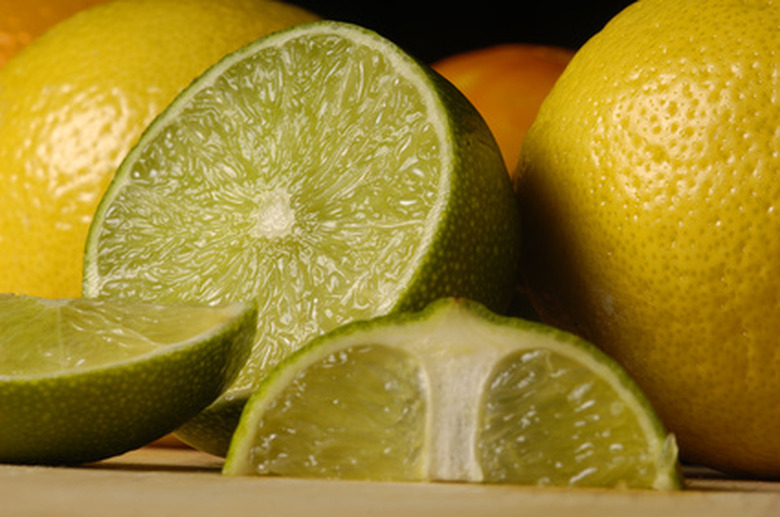Difference Between Orange & Lime Trees
Although very similar in many ways, limes and oranges have very different histories and uses. Both limes and oranges are citrus fruit, the flesh of which is segmented and made up of pulpy sacks that hold high quantities of juice. Citrus fruit also has an outside rind, or skin, that is high in citrus oil.
History
The early history of both limes and oranges is not well known or documented in the West. Both oranges and limes originated in Southeast Asia. However, the original Southeast Asian oranges were likely sour oranges. According to Food Timeline, the sweet orange may have originated in Southeast Asia or in China. The first mention of sweet oranges in Europe is during the 15th century. Most varieties of limes were created by hybridizing key limes, the original limes from Southeast Asia. Limes were dispersed through the Middle East and North Africa by traders. They were first mentioned in European literature in the 13th century and was brought to North America during the 16th century.
- Although very similar in many ways, limes and oranges have very different histories and uses.
- The early history of both limes and oranges is not well known or documented in the West.
Tree Size
Orange trees are slightly larger than lime trees. Although trees grafted to dwarf root stock are smaller, the natural size of most lime trees is about 20 feet in height and spread. Orange tree size varies, depending on the variety, but is generally between 25 feet and 30 feet in height and spread. In most cases, the branches of the two trees will curve downward in a weeping form and nearly touch the ground, especially when heavy with fruit.
Types
There are many different types of both lime trees and orange trees. Limes start with the small, round key limes, thought to be the original lime. Larger Mexican, Persian and Tahitian limes are thought to be hybrids between the key lime and a citron. The skins of the limes produced by these trees are thicker. The origins of sweet oranges are even less well documented. However, there are many varieties of sweet oranges, including satsuma, mandarin, naval and Valencia. In some cases, different varieties of oranges are cross-bred to create new commercial cultivars.
- Orange trees are slightly larger than lime trees.
- Although trees grafted to dwarf root stock are smaller, the natural size of most lime trees is about 20 feet in height and spread.
Identification
Identifying a tree as a lime tree or an orange tree between fruit crops can be very difficult. The leaves of the two trees are very similar and the bark can be similar. The best way to identify a tree is to look at its fruit. Limes are green skinned, even when ripe. Oranges are orange skinned.
Function
The two trees are typically grown for their fruit, however, the fruit is used in very different ways. Sweet oranges are grown for juice and fresh consumption. Limes are acidic and sour and are usually used as a flavoring agent in juices and food. During the early expansion of the British Empire, sailors discovered that something in limes, now known to be vitamin C, prevented scurvy. Ships carried limes and British sailors were nicknamed "limeys."
- Identifying a tree as a lime tree or an orange tree between fruit crops can be very difficult.
- The two trees are typically grown for their fruit, however, the fruit is used in very different ways.
